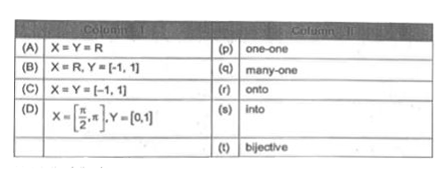If defined by is an invertible function, then the correct statement can be
The correct Answer is:D
To solve the given problem, we need to analyze the function f(x)=sinx−cosx+3√2 and determine its range, as well as the corresponding domain for its inverse function. Here’s a step-by-step solution:
Step 1: Identify the function and its components
The function is given as:
f(x)=sinx−cosx+3√2
We need to find the range of f(x).
Step 2: Find the range of sinx−cosx
The expression sinx−cosx can be rewritten using the formula for the range of asinx+bcosx:
Range of (asinx+bcosx)=(−√a2+b2,√a2+b2)
Here, a=1 and b=−1:
Range of sinx−cosx=(−√12+(−1)2,√12+(−1)2)=(−√2,√2)
Step 3: Adjust the range for the entire function f(x)
Now, we add 3√2 to the range of sinx−cosx:
Range of f(x)=(−√2+3√2,√2+3√2)
Calculating the endpoints:
- Lower bound: −√2+3√2=2√2
- Upper bound: √2+3√2=4√2
Thus, the range of f(x) is:
Range of f(x)=(2√2,4√2)
Step 4: Determine the domain of the inverse function
Since f is an invertible function, the range of f(x) becomes the domain of the inverse function f−1(x):
Domain of f−1(x)=(2√2,4√2)
Step 5: Find the range of the inverse function
To find the range of f−1(x), we need to analyze the original function f(x) and its behavior:
1. The domain of f(x) is all real numbers R.
2. The range of f−1(x) corresponds to the domain of f(x).
Step 6: Determine the range of f−1(x)
The function f(x) is continuous and differentiable, and since it is invertible, we can find the critical points to determine the range. The range of f−1(x) will be the interval where x takes values in the domain of f.
Step 7: Finalize the ranges
The range of f−1(x) is determined to be:
Range of f−1(x)=(−π4,3π4)
Conclusion
Thus, we conclude:
- The range of f(x) is (2√2,4√2).
- The range of f−1(x) is (−π4,3π4).
The function is given as:
f(x)=sinx−cosx+3√2
We need to find the range of f(x).
The expression sinx−cosx can be rewritten using the formula for the range of asinx+bcosx:
Range of (asinx+bcosx)=(−√a2+b2,√a2+b2)
Here, a=1 and b=−1:
Range of sinx−cosx=(−√12+(−1)2,√12+(−1)2)=(−√2,√2)
Now, we add 3√2 to the range of sinx−cosx:
Range of f(x)=(−√2+3√2,√2+3√2)
Calculating the endpoints:
- Lower bound: −√2+3√2=2√2
- Upper bound: √2+3√2=4√2
Range of f(x)=(2√2,4√2)
Since f is an invertible function, the range of f(x) becomes the domain of the inverse function f−1(x):
Domain of f−1(x)=(2√2,4√2)
To find the range of f−1(x), we need to analyze the original function f(x) and its behavior:
1. The domain of f(x) is all real numbers R.
2. The range of f−1(x) corresponds to the domain of f(x).
The function f(x) is continuous and differentiable, and since it is invertible, we can find the critical points to determine the range. The range of f−1(x) will be the interval where x takes values in the domain of f.
The range of f−1(x) is determined to be:
Range of f−1(x)=(−π4,3π4)
Thus, we conclude:
- The range of f(x) is (2√2,4√2).
- The range of f−1(x) is (−π4,3π4).
Similar Questions
Knowledge Check
If f:R→R defined by f(x)=2x−74 is an invertible function, then f−1 =
A4x+52B4x+72C3x+72D9x+x5
The function f:R→R be defined by f(x)=2x+cosx then f
View SolutionIf f:[−20,20]→R defined by f(x)=[x2a]sinx+cosx is an even fucntion, then set of values of a is
View SolutionLet f:A→B be a function defined by f(x)=√3sinx+cosx+4. If f is invertible, then
View SolutionThe function f(x)=tan−1(sinx+cosx) is an increasing function in
View SolutionLet f:R→R be defined by f(x) = cos (5x+2). Is f invertible? Justify your answer.
View SolutionLet f:X→Y be a function defined by f(x)=sinx.

View SolutionIf f:R→S, defined by f(x)=sinx−√3cosx+1,ison→, then find the set S.
View Solution
